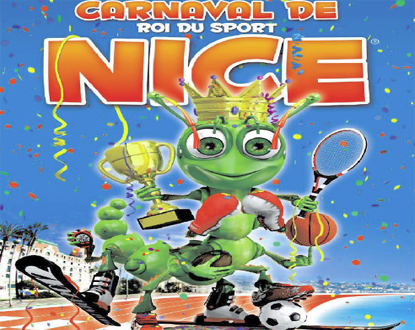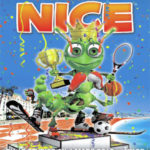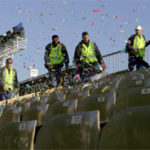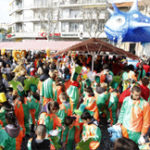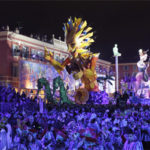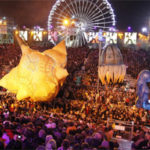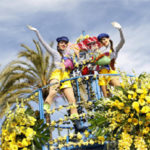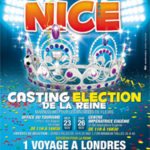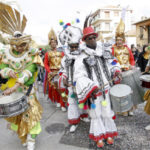From February 17 to March 4, 2012, His Majesty will reign over the 128th edition of the Nice Carnival, the most important event on the Côte d’Azur in winter. This year, the theme will be Sport. His Majesty will be the King of Sport. A nod to Olympic news
London 2012, as well as to the sporting dynamism of Nice, France, or more broadly, the planet.
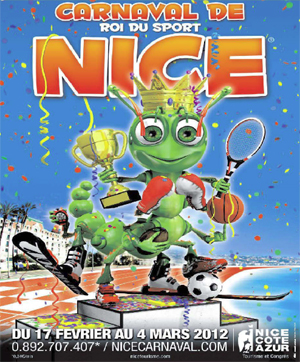
The guest of honor: Great Britain
His Majesty will host a guest of honor: Great Britain.
Indeed, given that the most significant sporting event in the world will take place on its soil, it was legitimate to grant it this title. It also highlights the historical ties with Nice.
An entirely revamped program
The program for this edition has been completely redesigned based on the different audiences of the Carnival. Thus, Tuesday afternoon will feature a carnival parade, and Wednesday will see a Battle of Flowers followed by an illuminated parade. This new arrangement is more family-friendly and facilitates the creation of packages for visitors from other regions or even other countries…
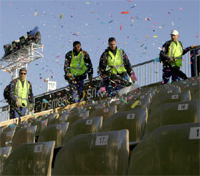
The carnival continues its ecological approach, in tune with sustainable development as is the entire city, and remains true to the spirit of this great popular festivity. Humor, derision, and poetry will be present.
A few actions, such as choosing eco-labeled companies and services that incorporate recycling from the tender, come into play for this 2012 Carnival. After testing 5 electric cars in 2011, all the towing vehicles for the Battle of Flowers will be electric.
At each event, 4 to 5 tons of waste collected by the municipal cleaning services are recycled. It takes 1 hour and 30 minutes of cleaning after each Battle of Flowers and 2 hours after each Carnival parade.
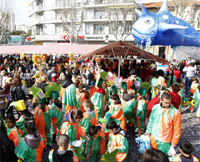
If the term transgression is always a foundation of a carnival, the term transmission is celebrated in Nice. For decades, the study of the carnival has been part of the primary school curriculum. Children are initiated into the tradition while creating their costumes to participate in the festivity.
The signing of an agreement between the city and/or civil bodies and the rectorate expands the educational scope up to the university level. A degree in performing arts with an option in carnival techniques and symbolism is underway for validation at the ministry and should materialize in 2012 at the Faculty of Arts of the University of Nice Sophia-Antipolis.
For two years, neighborhood carnivals have multiplied. Under the impulse of the OTC and its coordinator, Annie Sidro, carnival historian, each territory organizes Aubades and Charivaris. The administrative offices and social and cultural associations of all neighborhoods have created real events throughout the city. Along with conferences and exhibitions, the activities are an inseparable cultural complement to a heritage event.
Large carnival parades take place in Ariane, Bon-Voyage-Pasteur, Moulins-St-Augustin, Nice-north, and City Centre, Madeleine-Bornala. The neighborhood groups have thus designed their own Charivaris. The marchers will be accompanied by musical groups and “Giants” of the great Nice carnival. Costumes have been created based on the chosen staging.
This year, the Arrival of the King will be accompanied by a thousand children from the city’s schools.
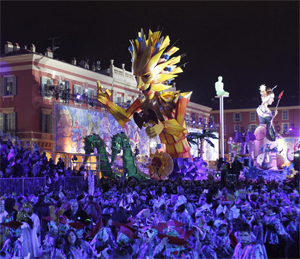
On Friday evening, His Majesty Carnival arrives at Place Masséna to seize the keys to the city, heralding the reign of the ephemeral; then, all madness is allowed, originality and exuberance are in order.
The parade consists of 20 floats designed according to the theme, about 50 papier-mâché “big heads,” and more than a hundred animation elements, genuine satellites of the floats. It becomes a colorful procession with vibrant colors intertwined with street arts and musical groups from around the world. In the evening, all the floats are illuminated, and the parades light up the heart of Nice.
On the last night, according to tradition, His Majesty Carnival parades only with his Queen before being burned on a bonfire at sea or sometimes on the beach. The Castle Hill ignites, and in echo, a sound-tracked fireworks display is then launched over the Bay of Angels.
The creation of a “papier-mâché” character is an ancestral tradition: in a mold, the layers of paper are successively glued on top of each other. Then, painters give the true signature to this nuanced Nice art. Today, only the covering offers the illusion of “papier-mâché.”
Each Carnival is an original production. Being a carnival artist is not a profession, but a passion, a vocation. The vast workshop in which these artisans work, called the “House of Carnival,” turns into a magical place for a few months. This work is the result of collaboration with an artistic coordinator from the cinema and advertising.
While new processes, techniques, and materials have enabled mechanization and modernization of the subjects, the fundamentals of float and “big head” manufacturing remain the same as at the origin.
With an ever-increasing artistic demand, carnival artists enlist the expertise of sculptors to enhance the quality and beauty of the floats.
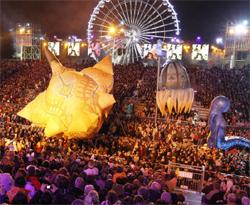
The animation elements are satellites of the floats designed according to each theme and accompany them in the parade. They can reach up to 6 meters in height and significantly contribute to the event’s scenography.
These elements take very diverse forms, utilizing various materials and techniques. Thus, the traditional “Big Heads” made in papier-mâché, numbering 50, stand alongside elements in inflatable structures or subjects in plastazote or resin castings…
In total, nearly 110 pieces reinforce the animation setup of the Carnival parade.
The BAT
The Animation Tribunes Brigade, specifically created for the event, brings together performing artists with high energy to inject more life into the grandstands and the Nice Carnival parade.
60 classical or street acrobats (stunts, jumps, urban balance), stilt walkers, jugglers, equilibristists, contortionists, and urban dancers (hip hop, street dance, tectonic), half of whom are amateurs, work to multiply the celebration. These artists then invite everyone to join in. A choreography announcing the program’s launch marks the start of the parade.
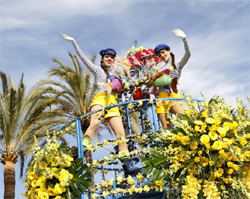
In 1876, Andriot Saëtone created the first Battle of Flowers on the Promenade des Anglais. They have retained this prestigious setting ever since. Initially, they consisted of simple flower exchanges, then turned into a true spectacle over time.
Originally, the Battles of Flowers were created to entertain the first tourists from the European aristocracy, then maintained to honor the work of local producers, dear to Alphonse Karr, a writer-botanist attached to Nice.
Today, this event showcases the quality and wide variety of azurean florals since 85% of the flowers used are locally produced. The 20 fully flower-covered floats parade on the Promenade des Anglais between Avenue des Phocéens and the Negresco Hotel. On each float, costumed mannequins throw 80,000 to 100,000 flowers to the enthusiastic public, including gladioli, tokyos, mimosas, gerberas, daisies, roses, carnations…
This event is a unique spectacle worldwide and ranks among the most famous festivities on the Côte d’Azur. Nice exports this savoir-faire in elegance, beauty, and charm through the Battles of Flowers worldwide.
These battles are in harmony with the carnival floats, a procession of plant-based displays on the same theme. Their realization represents meticulous and long work, yet accomplished in a very short time by the masters of the piercing art, the florists. The costumes are created in a dedicated creation workshop, and they are unique models conceived as for the theater.
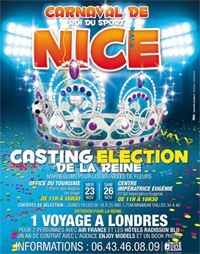
Each year, the election of the Queen of the Nice Carnival takes place online at www.nicecarnaval.com. In 2011, over 16,400 internet users from 52 countries voted.
In January, internet users worldwide will be able to vote for their favorite candidate among the eight selected young women.
A profile of each will allow visitors to the carnival’s official site to discover them in all their splendor. It will contain a clip shot at an emblematic city location and some additional information about their passions and personalities.
The results will be announced in a prelude to the event during the presentation of the queen and her two runners-up.
Ten voters, drawn at random, will win prizes for their participation.
The Floats
Eric DUBREIL, artistic coordinator from the film industry, imagined and designed modular floats.
Thus, the floats of the Battles of Flowers are now all created to offer a panoramic 360-degree visibility. Their mechano-type structure and much more modern architecture allow an increase in volumes and platforms.
Some have multiple levels. These advantages benefit the event: the ability to create real scenography on the float and, for photographers and cameramen, new angles of view.
The Florists
They are about twenty in number, entering the workshop 72 hours before each event to indulge in flower piercing. This ephemeral art is carried out in a universe of colors and scents worthy of a beehive…
The Costumes
Designed in the Battle of Flowers costume workshop, they reflect every facet of sport, fitting perfectly with the Carnival’s theme.
The selection of fabrics and materials highlights recycling and imagination.
The creations stem from a collegiate work carried out with enthusiasm and passion by four costume designers, all experienced in the performing arts.
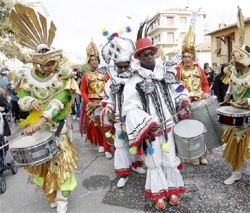
A true reference of the Nice Carnival, street arts pace the parades and link their universe, culture, and imagination to the original floats of the parades and the famous Battles of Flowers.
This year again, the street art troupes will respond to a desire for openness to the world linked to Azorean creation. Nearly 70 groups from worldwide, divided into one-third professionals, one-third amateurs, and one-third locals, will present their performances during the parades.
The main street art troupes have participated in the parades, creating synergy between the traditional carnival scenography and their own dramaturgy. A tested alchemy. For several years, some companies have come in residence on the carnival for the entire duration of the event.
Not to forget the carnival troupes invited each year to join the parades.
THE PLAYFUL GARDEN – Albert 1st Garden
The playful garden is a space dedicated to children where multiple free activities are offered: makeup, mask creation, kite-making, stories, and shows… from 11 am to 5 pm, every day of the events.
Artistic recycling is one of the fundamentals of this garden, where all these animations, led by professional artists, attract numerous children.
Parents can simultaneously enjoy socca, a chickpea flour pancake according to the traditional Nice recipe.
During the Carnival, an Office information point provides information to visitors on event days.

Friday, February 17
8:30 pm – Arrival of the King and Queen accompanied by a thousand city schoolchildren.
Saturday, February 18
2:30 pm – Battle of Flowers
9 pm – Illuminated Parade
Sunday, February 19
2:30 pm – Carnival Parade
Tuesday, February 21
2:30 pm – Carnival Parade – Mardi Gras
Wednesday, February 22
2:30 pm – Battle of Flowers
9 pm – Illuminated Parade
Saturday, February 25
2:30 pm – Battle of Flowers
9 pm – Illuminated Parade
Sunday, February 26
2:30 pm – Carnival Parade
Tuesday, February 28
2:30 pm – Carnival Parade
Wednesday, February 29
2:30 pm – Battle of Flowers
9 pm – Illuminated Parade
Saturday, March 3
2:30 pm – Battle of Flowers
9 pm – Illuminated Parade
Sunday, March 4
8 pm – Closing Festivities – Incineration of the King
9:30 pm – Fireworks
Carnival in Numbers
The Attendance
In 2011, the attendance was more than satisfactory, and the box office benefited first, with a 10% increase. These 10% take into account the fact that a battle of flowers had to be canceled in 2010, the same positive movement of attendance estimated at over a million in the city. More than 184,140 tickets issued were sold during the Carnival, with total revenues ordemonstrating 2,338,400 €.
The total economic impact is estimated between 30 and 35 M € for a budget of approximately 6.8 M €.
The Carnival Procession
• 20 floats 12 meters long by 3 meters wide and from 8 to 18 meters high
• The top 3 floats in the procession are always the King, the Queen, Carnivalon, and their court of 17 floats
• About twenty different groups each weekend participate in parades and battles of flowers
• 1/3 are street arts and Nice and regional music
• 1/3 are musical delegations and 1/3 are entertainment troupes from around the world
• 20 tons of confetti will be used in the parades and battles of flowers by spectators and artists… These iconic confetti of parades have become over time the inevitable actors of a successful Carnival; numerous troupes and even some floats will bombard the processions with multicolored dots and flowers…
• 4 to 5 tons of waste and other remains of the party are collected by the city’s cleaning service in 1:30 on the battles of flowers and 2 h on the parades.
The Big Heads
• Nearly 150 animation elements, float satellites of which 50 are traditional papier-mâché “Big Heads”
• Their weight varies between 10 and 12 kg, half as much for those made of plastazote and a tenth for inflatable structures
• Any bearer of a traditional big head expends energy estimated at a megajoule during the event
• For 3 weeks, they perform the equivalent of a marathon
The Float of Battle of Flowers
• 2,500 to 3,000 fresh flower stems, 85% of which are locally produced, planted since November
• Its dimensions are 7 meters long by 2 meters wide and 6 meters high, all modular
• 72 hours of piercing, concentrated in 2 and a half days
• 400 sponge blocks, 10 kg of wire and 12.5 meters of garden mesh
• 2 mannequins per float launch about 20 kg of mimosa and cut flowers.
